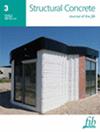结构应用中早期强度的重要性:基于黑曜石的土工聚合物砂浆和硅灰替代物研究
IF 3.3
3区 工程技术
Q2 CONSTRUCTION & BUILDING TECHNOLOGY
引用次数: 0
摘要
土工聚合物砂浆比混凝土及其原材料水泥的二氧化碳排放量更少,是一种创新、环保和可持续的建筑材料。土工聚合物是用碱性活化剂活化二氧化硅和氧化铝材料而形成的。本研究调查了一种土工聚合物砂浆,其中含有游离的黑曜石(OB)(又称火山玻璃)和硅灰(SF)(硅和硅铁工业的废料)。研究了基于 OB 的土工聚合物砂浆在 2 至 120 小时不同固化时间和 90、150 和 200°C 不同热处理温度下的行为。研究了 OB 和 SF 对土工聚合物的物理特性、抗压强度(CS)和微观结构的影响。结果表明,在 90 和 150°C 热处理温度下,96 小时内获得的 CS 值达到峰值,而在 200°C 热处理温度下,72 小时内获得的 CS 值最高。当固化时间超过理想极限时,CSs 会降低。研究发现,OB 基土工聚合物与 SF 具有良好的稳定性,SF 替代率与 CS 之间呈线性关系。砂浆的密度随着热固化时间的增加而降低。随着热温度和固化时间的变化,微观结构变得更加致密,微空洞和裂缝减少。据观察,SF 替代降低了土工聚合物的总孔径,并使孔隙结构尺寸减小。这项研究的结果有望鼓励在制造土工聚合物时利用工业废料和新型粘合剂。本文章由计算机程序翻译,如有差异,请以英文原文为准。
The importance of early strength in structural applications: Obsidian‐based geopolymer mortars and silica fume substitution study
Geopolymer mortars, which cause less CO2 emissions than concrete and its raw material cement, are an innovative, environmentally friendly and sustainable building material. Geopolymers are formed by activating silica and alumina materials with alkaline activators. In this study, a geopolymer mortar containing obsidian (OB), also known as volcanic glass, which is free, and silica fume (SF), which is the waste material of the silicon and ferrosilicon industry, was investigated. The behavior of OB‐based geopolymer mortars under different curing times ranging from 2 to 120 h and different thermal treatment temperatures such as 90, 150, and 200°C were examined. The effectiveness of OB and SF on the physical features, compressive strength (CS), and micro‐structural of the geopolymers were characterized. Results demonstrated that the peak CSs were acquired in 96 h at 90 and 150°C heat treatment temperatures, while the highest CSs were acquired in 72 h for specimens subjected to 200°C heat treatment. Reduces in CSs were detected when the curing time exceeded the ideal limit. OB‐based geopolymer was found to be stable with SF and there was a linear relationship between SF substitution ratio and CS. The density of the mortar pieces decreased with increasing thermal curing hours. Devolving on the thermal temperature and curing time, the microstructures became more compact and microvoids and cracks decreased. It was observed that SF substitution reduced the total pore size of the geopolymers and allowed the pore structure size to be reduced. The results obtained from the study are expected to encourage the utilize of industrial wastes and new binders in the manufacture of geopolymers.
求助全文
通过发布文献求助,成功后即可免费获取论文全文。
去求助
来源期刊

Structural Concrete
CONSTRUCTION & BUILDING TECHNOLOGY-ENGINEERING, CIVIL
CiteScore
5.60
自引率
15.60%
发文量
284
审稿时长
3 months
期刊介绍:
Structural Concrete, the official journal of the fib, provides conceptual and procedural guidance in the field of concrete construction, and features peer-reviewed papers, keynote research and industry news covering all aspects of the design, construction, performance in service and demolition of concrete structures.
Main topics:
design, construction, performance in service, conservation (assessment, maintenance, strengthening) and demolition of concrete structures
research about the behaviour of concrete structures
development of design methods
fib Model Code
sustainability of concrete structures.
 求助内容:
求助内容: 应助结果提醒方式:
应助结果提醒方式:


